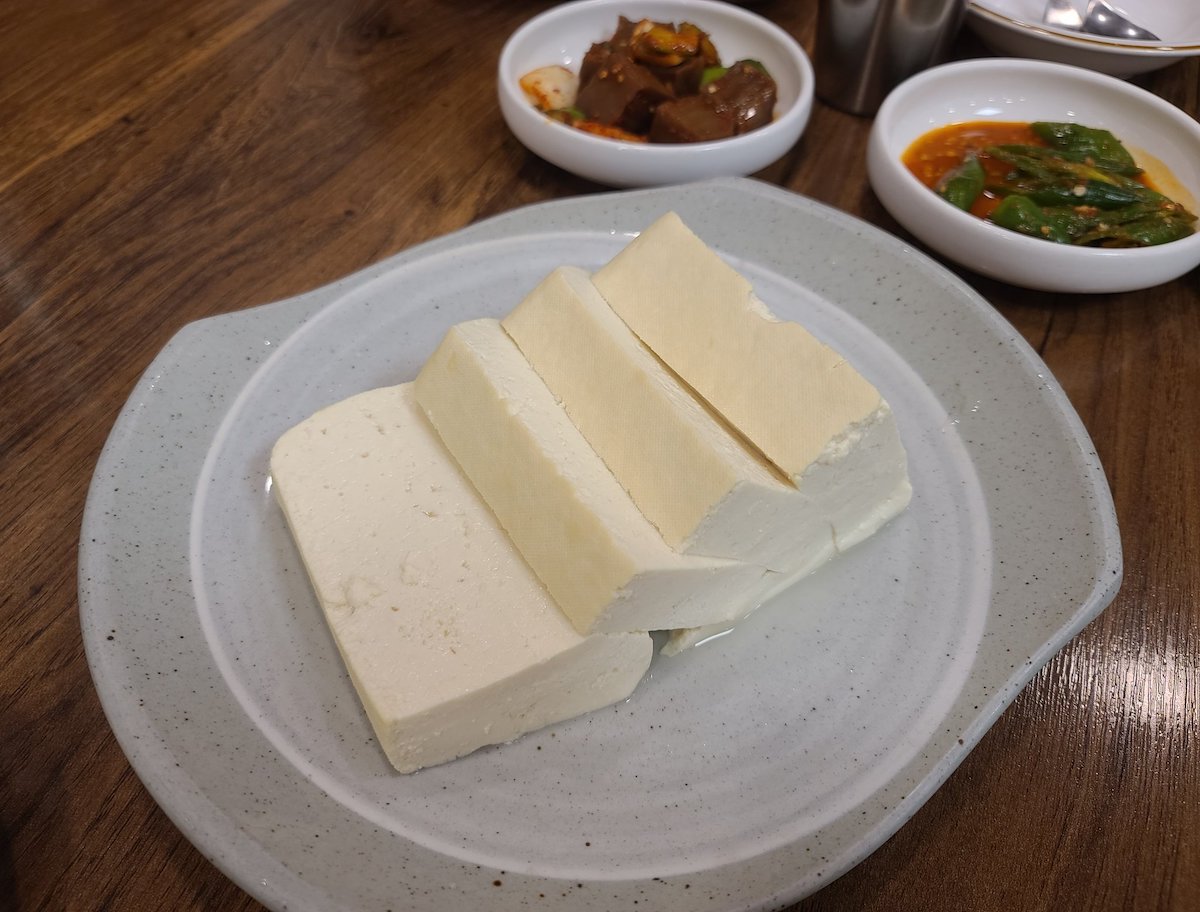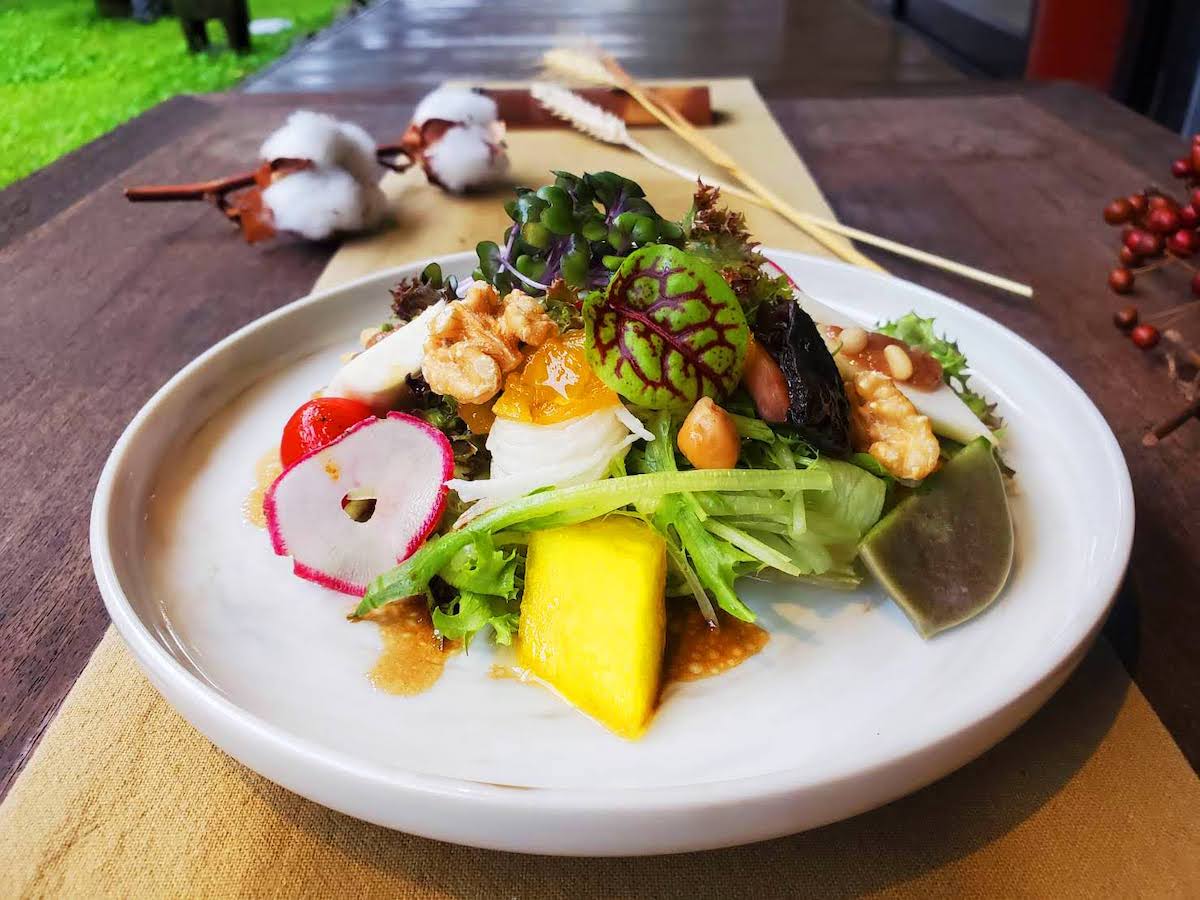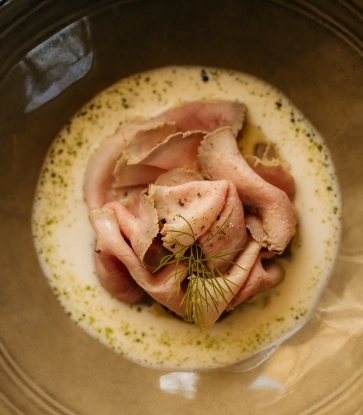As leaders in sustainable gastronomy, MICHELIN Green Star restaurants are at the top of their game when it comes to combining culinary excellence with outstanding eco-friendly commitments, which covers everything from waste management, the provenance of the ingredients to the balance of the menus.
While many of their daily efforts are behind the scenes, what they present on the plate serves as a reflection of their values and environmental beliefs. Take a look at what makes their dishes sustainable and worth ordering on your next visit.
RELATED: How MICHELIN Green Star Restaurants In Asia Are Doing Their Part With Sustainable Practices

MICHELIN Guide Hong Kong Macau
Amber
Two MICHELIN Stars and MICHELIN Green Star, MICHELIN Guide Hong Kong Macau 2022
Dish: Artichoke and morel
When Amber went dairy- and gluten-free in 2019, chef Richard Ekkebus steered the menu towards dishes consisting of 75% plant-based ingredients and 25% ethically sourced seafood and protein. “The plant kingdom for me is one of the most exciting playfields, there are so many textures, shapes and colours to work with—the possibilities are endless," he shares.
A seasonal dish that encapsulates Amber’s plant-based experience, morels from Yunnan, which is favoured for its powerful and concentrated flavour, is braised in a sauce made with the leaves of artichokes along with the trimmings of the morels, finished with a lacto fermented nut butter and preserved truffles. The versatility of artichoke is expressed in its cooked, raw and frit forms: part braised and caramelised on the plancha; and part served with pickled and seared spring onions. The finishing touch is complete with locally grown raw button mushrooms and mizuna leaves topped with chips and raw shavings of artichokes.

Roganic
One MICHELIN Star and MICHELIN Green Star, MICHELIN Guide Hong Kong Macau 2022
Dish: Aged duck with beetroot and red cabbage
True to Simon Rogan’s sustainability ethos, Roganic’s farm-to-table experience is driven by its commitment to sourcing from local, organic farms in the New Territories. In this dish, the duck is aged in house for 14 days and every part of it—crown, leg, carcass, skin—is utilised in different ways on the plate and glazed in a special local “100 Flower Honey” from Yuen Long.
All the vegetables on the dish, including the beetroot, red cabbage and preserved mulberry, are local and, most importantly, of good quality. “This combination is one of my favourites to eat with duck or perhaps pigeon or venison. I’d like to think it has a few little twists and reflects my personality alongside Simon’s ethos,” says chef Ash Salmon.
RELATED: Meet MICHELIN Guide Asia's Top Female Pastry Chefs And Their Signature Desserts

MICHELIN Guide Thailand
One MICHELIN Star and MICHELIN Green Star, MICHELIN Guide Thailand 2022Dish: Sunchoke, karonda fruit, sturgeon
The only MICHELIN Green Star restaurant in Thailand for two consecutive years is led by chef Jimmy Oporst and his creative kitchen crew. Not only do they help a local sturgeon producer in Hua Hin with their overpopulation by turning them into a delicious menu, but they also utilise the leftover bones to the fullest as a base to PRU’s special sauce, often described as one of the highlights of the dining experience, without any food waste.
The karonda fruit, fig leaf and chives are harvested from their 96-hectare organic farm with the compost from their kitchen waste as fertiliser. The sunchokes are grown on the farm as part of a flourishing project to grow their own by using leftovers. “This is the completion of a cycle because we are able to use the waste from our kitchen to start a new crop at the farm, which then supplies our kitchen,” says Jimmy Ophorst. He adds, “Sustainability starts with yourself, be the one who will take the next step to create a better version of the world we live in.”
RELATED: How PRU Saves The Planet While Winning MICHELIN Stars

MICHELIN Guide Tokyo
NARISAWA
Two MICHELIN Stars and MICHELIN Green Star, MICHELIN Guide Tokyo 2022
Dish: Soup of the Soil
"One of our specialities is 'Soup of the Soil' made with burdock. It is made with burdock that still has pieces of soil on it that contain no agricultural chemicals. The inspiration for this dish came from the sensation of “life of the land” in the energy transferred to my feet when visiting a field where organic farming is practiced," says chef Yoshihiro Narisawa.
"I tested the soil to confirm and obtain assurance of its safety. I also discovered that it contains microorganisms. The soil is safe and healthy. My desire is for customers to experience coexistence with nature through the dish."

MICHELIN Guide Kyoto Osaka
Miyamaso
Two MICHELIN Stars and MICHELIN Green Star, MICHELIN Guide Kyoto Osaka 2022
Dish: A basket of wild vegetables and flowers
“I find inspiration when I’m out in nature or when I encounter people who care about nature,” says chef Hisato Nakahigashi.
He only uses seasonal ingredients because he relies entirely on nature’s blessing. No food mileage is associated with the seasonal herbs he picks in the hills and fields, the vegetables grown in his home garden on the premises or the river fish caught nearby. The seasonal leaves that decorate the hassun (the second course in Kaiseki in Japanese) also come from the mountains. He transforms the blessings of the satoyama (village and mountain landscape in Japanese) into beautiful dishes and uses the changing of the seasons as his message.

Unkaku
One MICHELIN Stars and MICHELIN Green Star, MICHELIN Guide Kyoto Osaka 2022
Dish: Nozaki-yaki of small sea bream
Unkaku is a kaiseki restaurant conveying the charms of Osaka ingredients. Their speciality is “Nozaki-yaki of small sea bream”. The hard-boned fish is roasted for seven hours, coating in rape-seed oil to make the scales and fins fragrant. The whole thing from head to tail is edible in this sustainable dish that eliminates food loss.
Chef-owner Masaharu Shimamura came up with the dish based on the frugal mentality of using up good ingredients without letting anything go to waste. The sea bream he uses are raised with consideration of the environmental impact, and he puts sustainability into practice by protecting wild fish.

MICHELIN Guide Seoul
A Flower Blossom on the Rice
MICHELIN Green Star and Bib Gourmand, MICHELIN Guide Seoul 2022
Dish: Goatsbeard namul rice
A Flower Blossom on the Rice is a place that has consistently shown its efforts to present nature-friendly dishes. It recently started a vegan course menu, which took itself one step further towards sustainable gastronomy.
Goatsbeard namul rice prepared as a main dish in the vegan course menu is truly a dish made through time and season. This menu is made with hand-picked goatsbeard namul, organically grown brown rice, and traditional ganjang made by an artisan. “Goatsbeard namul has a meaty texture and nuance. And for me, this is the clear evidence that vegetables are just enough for our life,” says owner Song Jeong-eun.

Hwanggeum Kongbat
MICHELIN Green Star and Bib Gourmand, MICHELIN Guide Seoul 2022
Dish: Dubu (Korean tofu)
Hwanggeum Kongbat has a variety of dubu dishes, but the menu where you can feel the essence of dubu created by chef Taehyun Yoon is raw dubu. Terroir is dissolved in this pure dubu made by picking, grinding, and boiling the most delicious beans from this land. It is good to boil it in soup or stir-fry it with other seasonings, but the simplicity of dubu is good enough on its own.
Enjoy a piece of raw dubu with light ganjang (soy sauce) sauce. This is the moment the dubu, an ordinary ingredient, becomes an art. With this dubu, the body and mind become closer to the earth.

MICHELIN Guide Taipei & Taichung
Mountain and Sea House
One MICHELIN Star and MICHELIN Green Star, MICHELIN Guide Taipei & Taichung 2021
Dish: Crispy roasted chicken
This dish comes from the recipe of the famous Taiwanese cuisine fine dining restaurant Peng-lai-ge back in the Japanese occupation period. The free-range chicken is marinated with the traditional sauce and carefully roasted to get crispy skin and succulent meat.
This dish demonstrates the sustainable commitment of the Mountain and Sea House in a way that the restaurant makes great efforts to study and pass down the time-honoured recipe and tradition, while paying detailed and close attention to the ingredients. The free-range chicken they use is close to indigenous species and is humanely and naturally raised with no added growth hormones or antibiotics, which echos with the belief of the restaurant that “the most delicious flavours and good cuisine are always cultivated in the ground from natural and good ingredients.”
RELATED: Classic Fried Vermicelli from Mountain and Sea House

Yangming Spring (Shilin)
MICHELIN Green Star, MICHELIN Guide Taipei & Taichung 2021
Dish: Spring in Prague
The dish's name echoes with the restaurant and reminds diners of the comfortable environment and climate in Prague.
The base of the salad uses vegetables from the plant factory of the Taiwanese electronic company that is grown with close attention to the environment. For example, the effluent is cleaned and filtered and the vegetables are grown free from chemical fertilisers and pesticides. Above the vegetables are seasonal fruits from Taiwan—strawberries, tomatoes or pineapples in April—and water bamboo shoots that are seasoned and roasted with miso. The sauce is linseed oil or pumpkin seed oil cold-pressed by the restaurant and then blended with the balsamico.
The leftovers of vegetables and fruits do not go to waste, either. Executive chef Sean Hsueh makes it a point to use dragon fruit for plate decorations and turn dry pineapple leftovers into magical elements in chia seeds drinks.
RELATED: How Taipei's MICHELIN Green Starred Restaurants Combine Sustainability and Gastronomy

MICHELIN Guide Shanghai
Taian Table
Three MICHELIN Star and MICHELIN Green Star, MICHELIN Guide Shanghai 2022
Dish: Charcoal grilled pigeon, cereal, beetroot
“With our concept where individual plated dishes are served in all the seasonal set menus, we prepare the food portion size well in advance to avoid wastage. We are also reducing single-use plastic,” says chef Stefan Stiller.
Taian Table also works closely with vendors to adapt sustainable practices and encourage the elimination of packaging. By taking small steps, the restaurant works toward building a solid foundation for sustainable gastronomy.

MICHELIN Guide Beijing
King's Joy
Three MICHELIN Star and MICHELIN Green Star, MICHELIN Guide Beijing 2022
Dish: Assorted organic vegetable carpaccio
Seemingly simple, this dish brings out a gastronomic world characterised by authenticity, naturalness, healthiness, original flavours, and zen.
It is a planet-friendly and sustainable approach to choose vegetables from organic, green and natural farming, which minimises the use of pesticides, fertilisers, and herbicides that lead to negative consequences on soil, water and environment as a whole.
Presentation comes in high quality, low quantity, and large varieties. Excessive processing, cooking, and seasoning of ingredients are avoided to preserve food authenticity as well as eliminate waste, calling for “sustainability on table.”
The dish is paired with four sauces that stand for naturalness and purity: uniquely flavored mustard and soybean oil sauce, fresh and richly flavoured rose salt and termite mushroom oil, creamy and subtly sweet bean paste, and elaborately textured sesame paste. Mixing and matching the sauces allows seasonal flavours to meander through the teeth and complete with a lingering freshness.
CONTINUE READING: The Best Plant-Based Dishes from MICHELIN Restaurants
Written by Aileen Li in Shanghai, Wakana Kubo in Japan, Kim Nayoung in Seoul, Pruepat “Maprang” Songtieng in Bangkok, Pearl Yan in Hong Kong, and Hsieh Ming-ling in Taipei; introduction and edits by Pearl Yan.
Hero image: Courtesy of Roganic
Images in the article were provided by the restaurants unless otherwise specified.






















